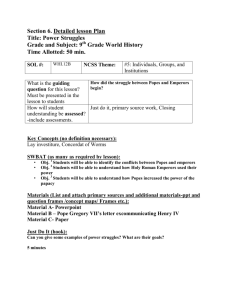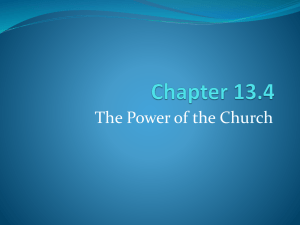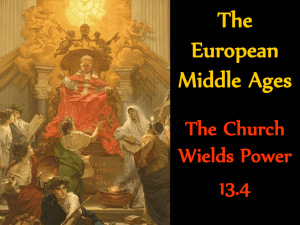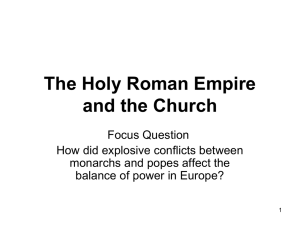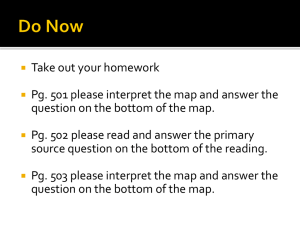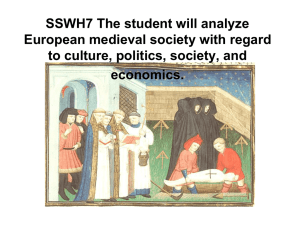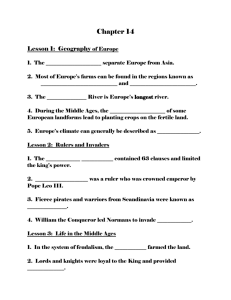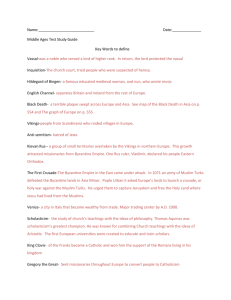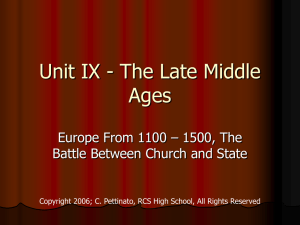The Holy Roman Empire & The Church
advertisement
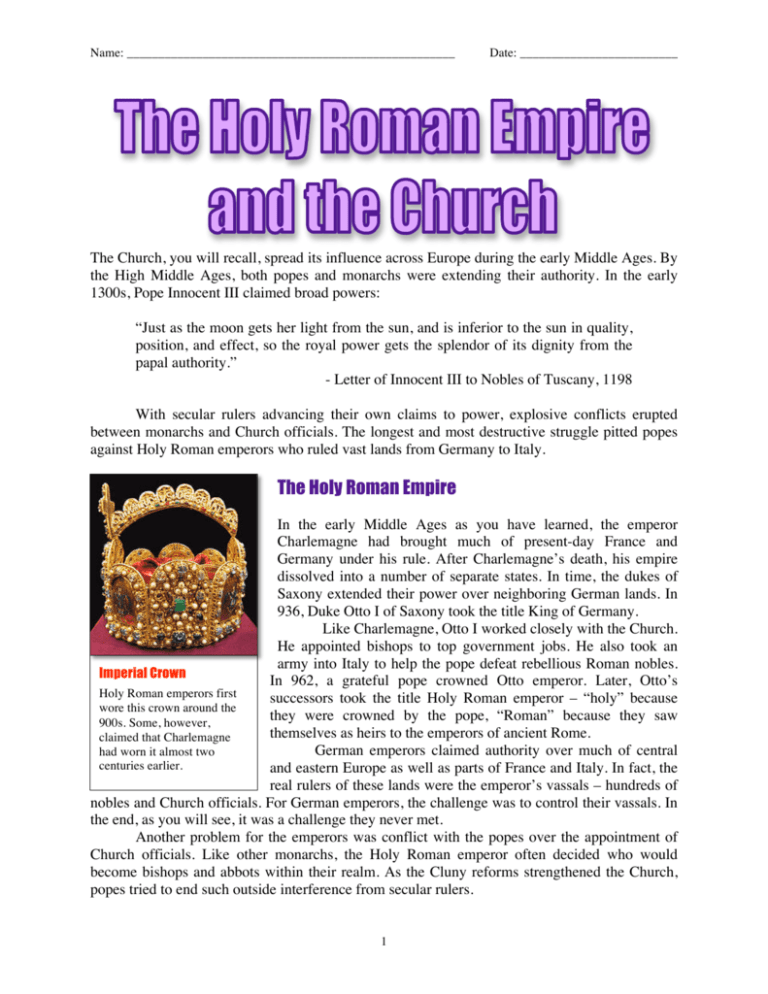
Name: ____________________________________________________ Date: _________________________ The Church, you will recall, spread its influence across Europe during the early Middle Ages. By the High Middle Ages, both popes and monarchs were extending their authority. In the early 1300s, Pope Innocent III claimed broad powers: “Just as the moon gets her light from the sun, and is inferior to the sun in quality, position, and effect, so the royal power gets the splendor of its dignity from the papal authority.” - Letter of Innocent III to Nobles of Tuscany, 1198 With secular rulers advancing their own claims to power, explosive conflicts erupted between monarchs and Church officials. The longest and most destructive struggle pitted popes against Holy Roman emperors who ruled vast lands from Germany to Italy. The Holy Roman Empire In the early Middle Ages as you have learned, the emperor Charlemagne had brought much of present-day France and Germany under his rule. After Charlemagne’s death, his empire dissolved into a number of separate states. In time, the dukes of Saxony extended their power over neighboring German lands. In 936, Duke Otto I of Saxony took the title King of Germany. Like Charlemagne, Otto I worked closely with the Church. He appointed bishops to top government jobs. He also took an army into Italy to help the pope defeat rebellious Roman nobles. Imperial Crown In 962, a grateful pope crowned Otto emperor. Later, Otto’s Holy Roman emperors first successors took the title Holy Roman emperor – “holy” because wore this crown around the they were crowned by the pope, “Roman” because they saw 900s. Some, however, themselves as heirs to the emperors of ancient Rome. claimed that Charlemagne German emperors claimed authority over much of central had worn it almost two centuries earlier. and eastern Europe as well as parts of France and Italy. In fact, the real rulers of these lands were the emperor’s vassals – hundreds of nobles and Church officials. For German emperors, the challenge was to control their vassals. In the end, as you will see, it was a challenge they never met. Another problem for the emperors was conflict with the popes over the appointment of Church officials. Like other monarchs, the Holy Roman emperor often decided who would become bishops and abbots within their realm. As the Cluny reforms strengthened the Church, popes tried to end such outside interference from secular rulers. 1 Name: ____________________________________________________ Date: _________________________ Conflict Between Popes and Emperors Under the reforming pope Gregory VII, the conflict between emperors and the Church burst into flames. Gregory was one of the greatest medieval popes. He was also among the most controversial. Primary Source POPE GREGORY VII Few Europeans of the time had a neutral view of Pope Gregory VII. Many admired and revered him. Among his enemies, however, he probably aroused more hatred and contempt than did any other pope of this time period. Gregory was determined to make the Church independent of secular rulers. To do so, he banned the practice of lay investiture. Under this practice, the emperor or another lay person (a person who is not a member of the clergy) “invested,” or presented, bishops with the ring and staff that symbolized their office. Only the pope, said Gregory, had the right to appoint and install bishops in office. EMPEROR HENRY IV Pope Gregory’s ban brought an angry response from the Holy Roman emperor Henry IV. He argued that bishops held their lands as royal fiefs. Since he was their overlord, Henry felt entitled to give them the symbols of office. The feud heated up as the two men exchanged insulting notes. Meanwhile, rebellious German princes saw a chance to undermine Henry by supporting the pope. A Pope Deposes a King On February 22, 1076, Pope Gregory VII issued this decree against Henry IV: “O St. Peter, chief of the apostles…I withdraw, through thy power and authority, from Henry the king…who has risen against thy church with unheard of insolence, the rule over the whole kingdom of the Germans and over Italy. And I absolve all Christians from the bonds of the oath which they have made…to him; and I forbid anyone to serve him as king. For it is fitting that he who strives to lessen the honour of thy church should himself lose the honour which belongs to him. And since he has scorned to obey…my commands which…I issued to him for his own salvation…I bind him in thy stead with the chain of [excommunication].” - Gregory VII,, First Deoposition and Benning of Henry IV THE STRUGGLE INTENSIFIES In 1076, Gregory excommunicated Henry, freeing his subjects from their allegiance to the emperor. The pope then headed north to crown a new emperor. Faced with revolts at home, Henry was forced to make peace with the pope. In January 1077, Henry crossed the icy Alps to Canossa. There, “with bare feet and clad only in a wretched woolen garment,” he presented himself to the pope as a repentant sinner. Gregory knew that Henry was just trying to save his throne. Still, as a priest, Gregory had no choice but to forgive a confessed sinner. He lifted the order of excommunication, and Henry quickly returned to Germany to subdue his rebellious nobles. In later years, he took revenge on Gregory when he led an army to Rome and forced the pope into exile. CONCORDAT OF WORMS The struggle over investiture dragged on for almost 50 years. Finally, in 1122, both sides accepted a treaty known as the Concordat of Worms (VOHRMS). In it, they agreed that the Church had the sole power to elect and invest bishops with spiritual authority. The emperor, however, had the right to invest them with fiefs. 2 Name: ____________________________________________________ Date: _________________________ The Struggle for Italy Although the investiture struggle was over, new battles were soon raging between popes and emperors. During the 1100s and 1200s, ambitious German emperors south to master Italy. As they did so, they came into conflict with popes and with the wealthy towns of northern Italy. Biography Innocent III 1160-1216 Lotario de’ Conti grew up in an influential Roman family. Several of his uncles were leading Church figures, including one pope. Lotario attended the finest schools of Europe, studying theology in Paris and law in Bologna. He became a leading expert on canon law and rose quickly through Church ranks. In 1198, he was elected pope, just one month before he was ordained a priest. One of Innocent’s most lasting achievements was to convene an important Church council in Rome. There, more than 1,000 Church officials established several practices that are still followed by Catholics today, such as regular confession of sins. FREDERICK BARBAROSSA The emperor Frederick I, called Barbarossa, or “Red Beard,” dreamed of building an empire from the Baltic to the Adriatic. For years, he fought to bring the wealthy cities of northern Italy under his control. With equal energy, they resisted. By joining forces with the pope in the Lombard League, they managed to defeat Barbarossa’s armies. Barbarossa did succeed, however, in arranging a marriage between his son Henry and Constance, heiress to Sicily and southern Italy. That move entangled German emperors even more deeply in Italian affairs. FREDERICK II The child of Henry and Constance, Frederick II, was raised in southern Italy. He was an able, arrogant leader, willing to use any means to achieve his ends. As Holy Roman emperor, Frederick spent little time in Germany. Instead, he pursued his ambitions in Italy. There, he clashed repeatedly and unsuccessfully with several popes. Like his grandfather, Frederick also tried but failed to subdue the cities of northern Italy. EFFECTS ON GERMANY AND ITALY While Frederick was embroiled in Italy, German nobles grew more independent. The Holy Roman Empire survived, but it remained fragmented into many feudal states. The German people paid a high price for their emperors’ ambitions. Unlike France and England, Germany would not achieve unity for another 600 years. Southern Italy and Sicily also faced centuries of upheaval. There, popes turned to the French to overthrow Frederick’s heirs. A local uprising against French rule in Sicily led to 200 years of chaos as French and Spanish rivals battled for power. The region that had once been a thriving center of culture was left in ruins. The Height of Church Power Pope Innocent III, who took office in 1198, embodied the triumph of the Church. As head of the Church, he claimed supremacy over all other rulers. The pope, he said, stands “between God and man, lower than God, but higher then men, who judges all and is judged by no one.” Innocent clashed with all the powerful rulers of his day. More often than not, the pope cam out ahead. As you have read, when King John of England dared to appoint an archbishop of Canterbury without the pope’s approval, Innocent excommunicated the king and placed his 3 Name: ____________________________________________________ Date: _________________________ kingdom under interdict. Innocent ordered the same punishment for France when Philip II tried unlawfully to annul, or invalidate, his marriage. The Holy Roman emperor Frederick II also felt the wrath of the powerful pope. In 1209, Innocent, aided by Philip II, launched a brutal crusade, or holy war, against the Albigensians in southern France. The Albigensians wanted to purify the Church and return to the simple ways of early Christianity. Tens of thousands of people were slaughtered in the Albigensian Crusade. After Innocent’s death, popes continued to press their claim to supremacy. During this period, though, the French and English monarchies were growing stronger. In 1296, Philip IV of France successfully challenged Pope Boniface VIII on the issue of taxing the clergy. After Philip engineered the election of a French pope, the papacy entered a period of decline. Questions 1. Identify a. Holy Roman Empire b. Gregory VII c. Henry IV d. Concordat of Worms e. Frederick II f. Innocent III g. Albigensian Crusade 2. Define a. lay investiture b. annul c. crusade 3. Why was the power of German emperors limited? 4. How did conflicts between popes and emperors affect the Holy Roman Empire? 5. How did conflicts between popes and emperors affect Italy? 6. How did Pope Innocent III assert the power of the Church? 7. How did the political development of the Holy Roman Empire differ from that of England and France? 8. What were the causes of the differences between the Holy Roman Empire and England and France? 9. Review the words of Innocent III at the beginning of this section. What point was he trying to make? 4
